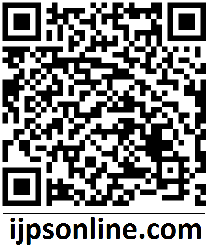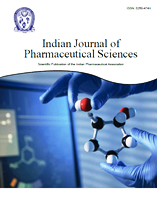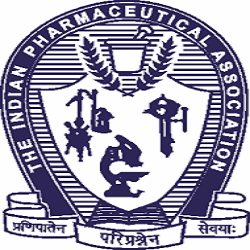- Corresponding Author:
- A. Sabitha Rani
Department of Botany, Osmania University College for Women, Koti, Hyderabad-500 095, India
E-mail: sabitaammana@yahoo.com
| Date of Submission | 12 May 2010 |
| Date of Revision | 2 March 2011 |
| Date of Acceptance | 28 March 2011 |
| Indian J Pharm Sci, 2011, 73 (1): 247-249 |
Abstract
Antifungal activity of Embelia ribes was evaluated on eight different fungal species by employing various concentrations of seed extract (0.5-2.0 mg). All the concentrations of seed extract inhibited the fungal growth, whereas maximum activity was observed at 2.0 mg concentration of seed extract. Among different doses, the diameter of inhibition zones ranged from 9 to 18 mm in various fungal species and increased with the increase in the concentration of test solution. Among all the fungi, high inhibition zones were observed in Colletotricum crassipes (18 mm). This was followed by Cladosporium (17.5 mm), Armillaria mellea (17 mm), Colletotricum capsici (17 mm), Aspergillus niger (16.5 mm), Rhizopus oryzae (16.5 mm), respectively. Aspergillus terreus and Candida albicans showed less inhibition zones (15.5 and 16.0 mm) compared to other organisms. The present study clearly demonstrated the antifungal properties of Embelia ribes.
Keywords
Antifungal activity, bioassay, Embelia ribes, seed extract, zone of inhibition
Higher plants are the source of numerous chemicals of commercial significance. They have impressive biological properties like antifungal, antibiotic, insecticide, pharmacological activities and are used as drugs, fragrance, food flavours, colours. In recent years, there is a great demand for plant-based products because of broad biological activities, low impact on environment and safety to non-target organisms. During last few decades, many plant species were screened and plants with high bioactive compounds were identified. E. ribes is an important medicinal plant with rich source of insecticidal and antimicrobial compounds.
Embelia ribes Burm. (Family-Myrsinaceae) commercially known as Vidang or Baibirang is one of the important medicinal plants of India. The plant is a climber with slender branches and long internodes. The leaves are elliptic, broad and covered with minute glands. The flowers are small, white racemes arranged in panicle inflorescence at the end of the branches. The fruits are berries, round, red to black colour and tipped with style [1]. The seed resembles so much to pepper and often referred as false pepper and pepper is also used to adulterate Embelia.
The fruits are astringent, carminative and stimulants. Traditionally the seeds are employed as a remedy for toothache, headache and snakebite. The seeds are mainly used for maintaining healthy skin and to support the digestive function [2]. It is also effective in the treatment of fevers and for the diseases of chest. The plant is used in more than 75 Ayurvedic commercial formulations. Embelin is the principle chemical compound reported from the seeds [3]. It is also used as antifungal agent in ringworm infection and other chronic dermatitis. It has laxative activity and used as anthelmintic agent [4]. Seed extract possess antioestrogenic properties and specially used as contraceptive [5]. The present study has been taken up to evaluate the antifungal activity of Embelia ribes seed extract against various plant pathogenic fungi.
E. ribes seeds were collected from a private firm near Hyderabad, which were originally brought from the state of Kerala and authenticated in the Department of Botany, Osmania University, Hyderabad. Healthy, fresh seeds were washed with tap water for several times and dried under shade. Air-dried, finally powered seeds (500 g) were extracted with petroleum ether (60-80°) in a Soxhlet apparatus. The plant extract was further concentrated in rotavapour and residues were weighed. Different concentrations of stock solutions (0.5 mg to 2.0 mg) were prepared by dissolving the plant extract in dimethyl sulphoxide (DMSO).
Eight test organisms, Aspergillus niger (MTCC 281), Rhizopus oryzae (MTCC 262) Aspergillus terreus (MTCC 1281), Cladosporium species (MTCC 1003), Colletotricum crassipes (MTCC 2223), Collectotricum capsici (MTCC 2071), Armillaria mellea (MTCC 409) and Candida albicans (MTCC 183) were obtained from the Institute of Microbial Technology, Chandigarh and maintained on potato dextrose agar (PDA).
Agar cup bioassay was employed for testing of antifungal activity of plant extract [6]. The ready-made PDA medium (Himedia, 39 g) was suspended in distilled water and autoclaved at pressure of 15 lb/ sq in for 20 min. Seven day old cultures of test organisms (0.5 ml) were inoculated onto the medium. After inoculation, cups were scooped out from Petri plates with 8 mm sterile cork borer. To each cup, different concentrations of test solutions (0.5 to 2.0 mg) were added. Controls were maintained with DMSO and Bavistin (5 µg) was used as standard. The treated and the controls were kept in an incubator at 26º for 24 h to 78 h and inhibition zones were measured. Three to four replicates were maintained for each treatment.
Effect of different concentrations (0.5-2.0 mg) of E. ribes seed extract against eight different fungi is given in the Table 1. The antifungal activity was observed in all the concentrations tested, but less effective below the 0.5 mg concentration of seed extract, hence the data was not included. The minimum activity of extract at lower concentrations may be due to the crude nature of the test solution. Among different doses, the diameter of inhibition zones ranged from 9 to 18 mm among different fungal species and increased with the increase in concentration of test solution. Maximum antifungal activity was observed at 2.0 mg concentration of seed extract. A similar study of screening the natural plant extracts against different fungal and bacterial pathogens was well recorded [7-10]. Since plants have co-evolved with pathogens, it is reasonable to except a variety of such compounds with specific as well as general antifungal activity [11].
| Test fungi | Concentration of seed extract (mg) | ||||||||||
|---|---|---|---|---|---|---|---|---|---|---|---|
| 0.5 | 0.7 | 0.9 | 1.1 | 1.3 | 1.5 | 1.6 | 1.7 | 1.8 | 1.9 | 2.0 | |
| Aspergillusniger | 9 | 10 | 10 | 11 | 12 | 12 | 13 | 13 | 13.5 | 14.5 | 16.5 |
| Aspergillusterreus | 9 | 10 | 11 | 12 | 13 | 14 | 14 | 14.5 | 14.5 | 15 | 15.5 |
| Rhizopusoryzae | 10 | 11 | 12 | 13 | 14 | 15 | 15.5 | 15.5 | 16 | 16.5 | 16.5 |
| Cladosporium species | 11 | 12 | 12 | 13 | 14 | 15 | 16 | 16.5 | 16.5 | 17 | 17.5 |
| Armillariamellea | 10 | 11 | 12.5 | 13 | 13.5 | 14 | 15.5 | 16 | 16 | 17 | 17 |
| Colletotricumcapsici | 10 | 11 | 12 | 12.5 | 13 | 14 | 15 | 15.5 | 16 | 16.5 | 17 |
| Colletotrichiumcrassipes | 10 | 11.5 | 12.5 | 13 | 14 | 14.5 | 15 | 16 | 17 | 17 | 18 |
| Candida albicans | 9 | 10 | 11 | 12 | 13 | 14.5 | 15 | 15.5 | 15.5 | 16 | 16 |
*Average values of four replicates.
Table 1: Zone of inhit\bition of seed extract of embelia ribes for antifungal activity
The present study clearly showed that the seed extract of E. ribes exhibited antifungal activity against many fungal strains, which included plant pathogens also. Thus there is a possibility of developing Embelia ribes as an important source of biopesticide and antifungal agent. However, further studied are needed for isolation and purification of bioactive constituents.
Acknowledgements
The authors are grateful to UGC, New Delhi for financial support under Major Research Project (MJRP).
References
- Anonymous. The Wealth of India raw materials. Vol. 1. New Delhi: Publications and Information Directorate, CSIR; 1985. p. 183-7.
- Chopra RN, Nayar SL, Chopra IC, editors. Glossary of Indian Medicinal Plants. Vol. 1. New Delhi: CSIR Publications; 1966. p. 258.
- Chauhan SK, Singh BP, Agarwal S. Determination of Embelin from Embeliaribesby high performance thin layer chromatography. IndianDrugs 1999;36:41-3.
- Singh AG, Sharma RD, Chaturved C, Agarwal DK. Anthelmintic effect Kuberashadi Yoga in Intestinal worms among children. J Res Educ Indian Med 1993;12:27-31.
- Pandey D, Bisht M, Singh YN. Effect of EmbeliaribesBurm. Extracts on the reproductive parts of female wistar rats. J Nat Conserv 1993;5:25-8.
- Linday EM. Practical introduction to Microbiology. London: E and FN Spon Ltd; 1962. p. 177.
- Ahmad I, Mehmood Z, Mohammad P, Ahmed S. Antimicrobial potency and synergistic activity of five traditionally used Indian medicinal plants. J Med Aro Plant Sci 2000;22:173-6.
- Fabry W, Okemo PO, Ausorg R. Antibacterial activity of East African Medicinal Plants. J Ethnopharmocol 1998;60:19-24.
- Rojas G, Levaro J, Tortoriello J, Navarn V. Antimicrobial evaluation of certain plants used in Mexican medicine for the treatment of respiratory diseases. J Ethnopharmocology 2001;74:97-101.
- Sabitha Rani A, Satyakala M, Sandya Devi V, Suryanarayana Murthy U. Evaluation of antibacterial activity from rhizome extract of Acoruscalamus. J Sci Indian Res 2003;62: 623-5.
- Darkokar MP, Mathur A, Dwivedi S, Bhalla R, Kanuja SP, Kumar S. Detection of antibacterial in the floral petals of some higher plants. CurrSci 1998;73:187-9.




